H4SiW12O40-catalyzed cyclization of epoxides/aldehydes and sulfonyl hydrazides:An efficient synthesis of 3,4-disubstituted 1H-pyrazoles
Guoping Yng,Xunjie Xie,Mengyun Cheng,Xiofei Go,Xioling Lin,Ke Li,Yunyun Cheng,Yufeng Liu
a Jiangxi Key Laboratory for Mass Spectrometry and Instrumentation,Jiangxi Province Key Laboratory of Synthetic Chemistry,East China University of Technology,Nanchang 330013,China
b Henan Key Laboratory of Polyoxometalate Chemistry,College of Chemistry and Chemical Engineering,Henan University,Kaifeng 475004,China
Keywords:Silicotungstic acid Epoxides Aldehydes Sulfonyl hydrazides 3,4-Disubstituted 1H-pyrazoles
ABSTRACT A simple and efficient method for the synthesis of pyrazoles through a silicotungstic acid (H4SiW12O40)-catalyzed cyclization of epoxides/aldehydes and sulfonyl hydrazides has been developed.Various epoxides/aldehydes were smoothly reacted with sulfonyl hydrazides to furnish regioselectivity 3,4-disubstituted 1H-pyrazoles.The application of such an earth-abundant,readily accessible,and nontoxic catalyst provides a green approach for the construction of 3,4-disubstituted 1H-pyrazoles.A plausible reaction mechanism has been proposed on the basis of control experiments,GC-MS and DFT calculations.
Pyrazole moiety is ubiquitous in organic compounds with broad pharmaceutical activities,such as antitumor,antifungal,and analgesic activities.Thus,compounds containing pyrazole rings are widely used in medical and life sciences [1–6].Moreover,pyrazoles have also displayed applications in the preparation of metalorganic complexes,supermolecules,electroluminescent materials and utilized as essential ligands for metals [7–11].Owing to their prominent properties,extensive efforts have been made in the construction of pyrazole derivatives [12–16].
Over the past few decades,various methods have been developed for the construction of pyrazoles.The most commonly strategy for the acquisition of pyrazole derivatives is the condensation reaction between hydrazine and 1,3-electrophilic substrate [17–22].Among the reported methods,sulfonyl hydrazides,which are readily accessible,stable nature and stable solids,have been applied as the predominant nitrogen source for the construction of pyrazoles [23–26].For example,Wan and Hu groups reported the condensation of sulfonyl hydrazides with 1,3-dicarbonyl compounds to synthesis of 1,3,5-trisubstituted pyrazoles,respectively [27–29].The condensation of sulfonyl hydrazides withα,β-unsaturated carbonyl compounds to synthesis of 3,5-disubstituted pyrazoles have also been reported [30–32].Other 1,3-electrophilic substrates include 1,3-diarylpropenes [33],enaminones [34],propargylic alcohols [35,36],and related multicomponent variants [37–39]were also used to construct pyrazoles with sulfonyl hydrazides(Scheme 1).However,these methods usually suffer from harsh reaction conditions,poor regioselectivity,requiring special substrate sources,and most of the products remain restricted to 3,5-substituted pyrazoles.Therefore,the development of an environmentally benign,efficient and practical approach for the synthesis of pyrazoles from easily available substrates is highly desirable.

Scheme 1.General methods for the construction of pyrazole rings using sulfonyl hydrazides as predominant nitrogen source.
Herein,we report an efficient cascade reaction for the preparation of 3,4-disubstituted pyrazoles by cyclization of various epoxides or aldehydes with sulfonyl hydrazides.Notably,the utilization of environmentally benign and inexpensive polyoxometalates as highly efficient catalysts to synthesis the pyrazoles makes this transformation a green procedure [40–42].In addition,the large excess of sulfonyl hydrazides could be transformed to thiosulfonates under standard conditions,which represents an important class of organosulfur compounds with an array of biological activities including antibacterial,antiviral and antifungal activities [43–45].
Initially,we commenced our studies using 2-phenyloxirane(1a) and 4-methylbenzenesulfonohydrazide (3a) as the model substrates to screen the reaction conditions and summarized in Table 1.The results of the catalyst screening showed that Bronsted acids (entries 1–4) were able to catalyze the reaction and H4SiW12O40performed best,giving the desired product 4a in 41%yield (entry 4).Two representative Lewis acids,FeCl3and Cu(OTf)2,were tested as catalysts under the same conditions and did not form any desired product (entries 5 and 6).No product was obtained in the absence of catalyst (entry 7).After screening solvents,we found that 1,4-dioxane was the best solvent for this reaction,comparing with CH3CN,DCE,toluene and CH3NO2(entry 3vs.entries 8–11).The reaction worked better with the formation of 4a in 46% yield (Table 1,entry 12) when the reaction temperature was increased to 100 °C,and further increasing the temperature did not improve the yield.When we tried this transformation with 0.4 mmol 3a,the yield of 4a increased to 61%.Elevated the amount of 3a led to a decreased yield (Table 1,entries 15 and 16).The yield was increased to 87% when 4 mol% of H4SiW12O40was employed(entry 18).

Table 1 Conditions optimization.a

Table 2 Substrate scope of H4SiW12O40-catalyzed cyclization reaction.a
With the optimal reaction conditions in hand,we explored the substrate scope of this transformation with a range of sulfonyl hydrazides.As shown in Table 2,sulfonyl hydrazide derivatives with different functional groups were applicable to this reaction.Both electron-withdrawing and -donating substituted groups in the benzene ring of sulfonyl hydrazides could smoothly provide nitrogen source,producing the desired product 4a in moderate to high yields (Table 2,entries 1–8).In addition,the large excess of sulfonyl hydrazides could be transformed to corrsponding thiosulfonates in moderate to good yields under standard conditions(47%−78%,5a–5h).It is worth noting that although the sulfonyl groups were not involved in the reaction,the different substituted groups of sulfonyl hydrazides still had an effect on the yield of the product.Sulfonyl hydrazides with electron-donating groups afforded higher yield of 4a than those with electron-withdrawing groups.
Subsequently,the scope of the reaction was explored using a variety of epoxides (Table 3).The epoxides bearing -F,-Cl,-Br groups on the para-position of benzene ring were converted into the corresponding 3,4-disubstituted pyrazoles 4b–4d in good yields with different sulfonyl hydrazides,and corrsponding thiosulfonates could be obtained in 45%−73% yields.
To expand the substrate scope of this transformation,phenylacetaldehyde derivatives were also explored.As can be seen in Table 4,phenylacetaldehydes appeared slightly high reactive than corresponding epoxide derivatives (2a–2d).Generally,phenylacetaldehydes with substituents such asm-Me,p-OMe ando-Cl afforded the corresponding products (4e–4g) in good yields.
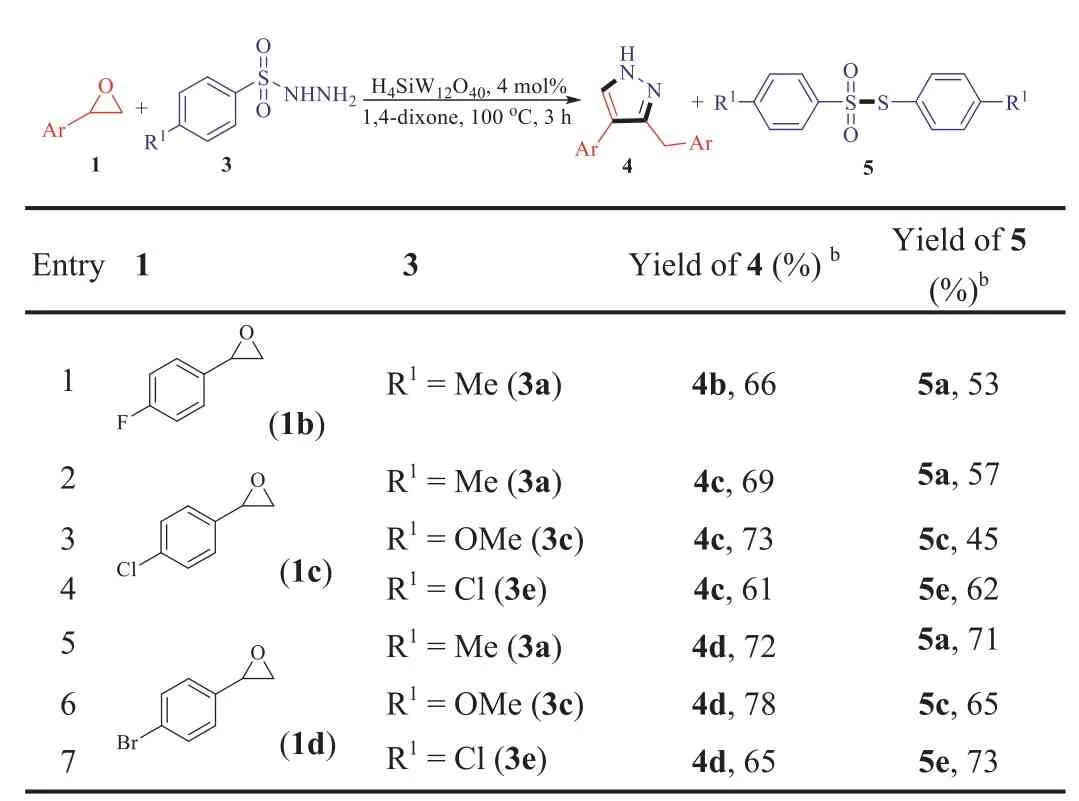
Table 3 Substrate scope of H4SiW12O40-catalyzed cyclization reaction.a
More practically,this reaction could be performed on a gramscale (10 mmol scale),clearly showing its potential application in organic synthesis (Scheme 2).The model product 4a from 2-phenyloxirane (1a) or phenylacetaldehyde (2a) with 4-methylbenzenesulfonohydrazide (3a) were investigated under the standard conditions,and the desired product 4a were obtained in 82% and 85% yields,respectively.
In order to gain insight into the reaction mechanism,several control experiments were conducted (Scheme 3).By addition of 2 equiv.radical inhibitor TEMPO,4a was still produced in high yield under standard conditions,which indicated that this reaction may not proceedviaa radical process (Scheme 3a).When the model reaction was stopped at 1 h,2-phenylacetaldehyde (2a),1-phenylethane-1,2-diol (A),2,4-diphenylbut-2-enal (B) and 4a were detected by GC-MS (Fig.S1 in Supporting information),which implied that 2a,A and B would be the key intermediates in this reaction (Scheme 3b).Under the standard reaction conditions,both 2a and B could be converted to 4a in 89% and 80% yields,respectively.However,Pure A could not be converted to 4a under the standard conditions (Schemes 3c-e).The results further proved that 2a and B were the key intermediates and A was not the key intermediate in this reaction.
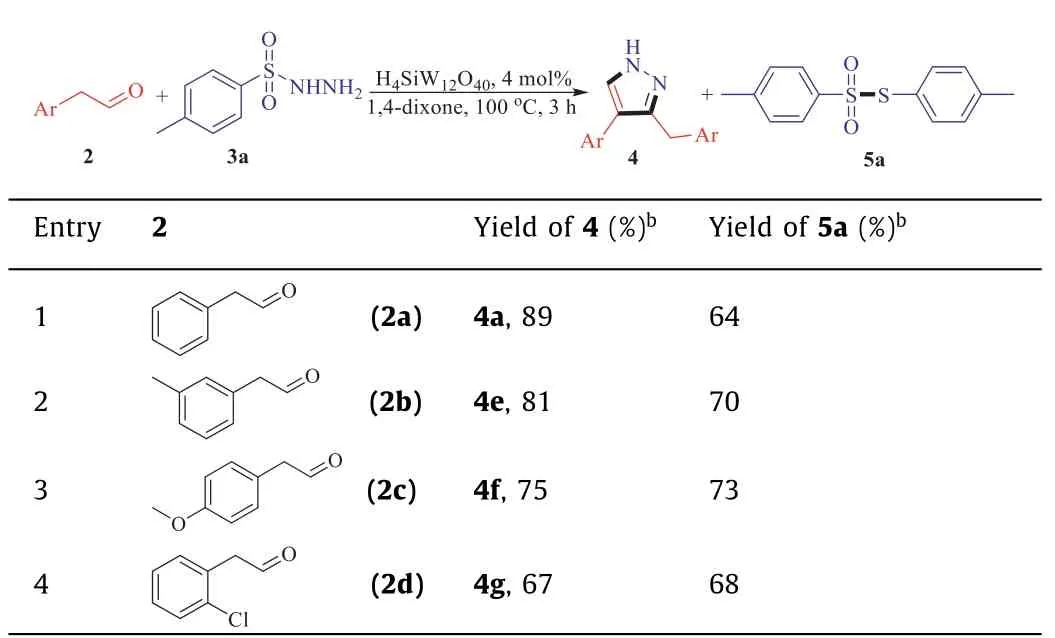
a Reaction conditions: 2 (0.4 mmol),3a (0.4 mmol),1,4-dioxane (1.0 mL),H4SiW12O40 (4 mol%),for 3 h.b Isolated yield.The yield of 5 based on 0.2 mmol 3.
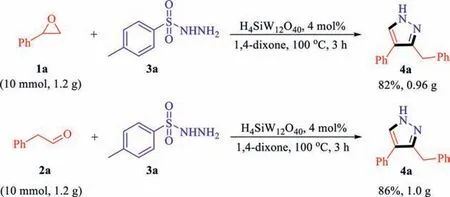
Scheme 2.Gram-scale reactions.
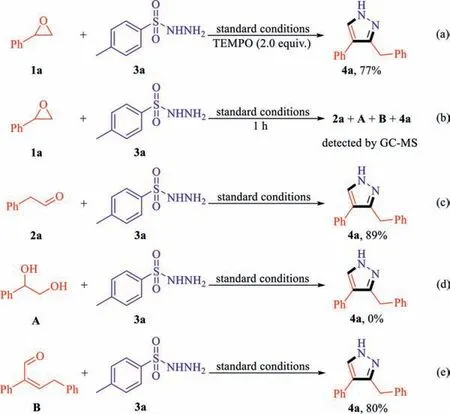
Scheme 3.Control experiments.

Scheme 4.Proposed mechanism.
Based on the above experiment results and relevant literature,a plausible mechanism was proposed in Scheme 4 [46,47].It is believed that 1a initially was catalyzed by H4SiW12O40to provide 2aviathe Meinwald rearrangement,which underwent the aldol reaction to afford the intermediate B.The condensation of 3a with B provided imine C,followed by the intramolecular addition to generate pyrazole 4a.
To better understand the reaction mechanism,a density functional theory (DFT) calculations are employed in the same experimental conditions (solvent of 1,4-dioxane,temperature at 373.15 K,and pressure at 1.00 atm) using M06-2X density functional.According to the proposed mechanism in Scheme 4,the whole reaction can be divided into four sub-reactions (1–4),which are shown in Fig.1 along with their Gibbs free energy change (ΔG) predicted by M06-2X/6–31G∗∗.TheΔGvalues of sub-reactions 1 and 4 are smaller than zero while those of sub-reactions 2 and 3 are larger than zero,indicating that sub-reactions 1 and 4 can occur spontaneously while sub-reactions 2 and 3 cannot.TheΔGvalue of sub-reaction 3 is larger than that of sub-reaction 2,which is larger than that of sub-reaction 1.This is consistent with the experimental result that key intermediates 2a and B are detected by GC-MS.Additionally,theΔGvalue of sub-reaction 4 is much smaller than that of sub-reaction 3,which explains why intermediate C cannot be detected by GC-MS experimentally.
It is generally known that the first three sub-reactions (1–3)are well known organic reactions,including Meinwald rearrangement of 1a to 2a,aldol condensation of 2a to B,and aldimine condensation of B and 3a to C.But we are not familiar with the last sub-reaction 4 of C to 4a.Therefore,its mechanism is calculated at the M06-2X/6–31G∗∗level and shown in Fig.2.Here,H4SiW12O40provides an acidic environment similar to protonic acid,thus,a simple H3O+-H2O model was used to estimateΔGvalues during protonation and deprotonation processes.Initially,C is readily protonated to form C-p,which is an exergonic process by 36.5 kcal/mol.Then,C-p undergoes intramolecular cyclization reaction through TS with an activation free energy of 22.1 kcal/mol to form cyclic intermediate D,which is also an exergonic process by 4.7 kcal/mol.Subsequently,both formation of TsH from D to E and departure of TsH from E to 4a–p are exergonic processes by 20.4 and 13.3 kcal/mol,respectively.The above steps are all exergonic processes,indicating that protonation of C,intramolecular cyclization of C-p,and both formation and departure of TsH can occur spontaneously.Finally,the experimental detected product 4a is formed after deprotonation of 4a-p,which is an endergonic process by 37.5 kcal/mol.Although deprotonation process is endergonic,the whole sub-reaction 4 is exergonic and spontaneous.These calculation results conclude that it is preferred to occur intramolecular cyclization process before formation and departure of TsH.Additionally,departure of TsH occurred before intramolecular cyclization is calculated to be an endergonic process by 75.0 kcal/mol (Fig.S2 in Supporting information),which also supports the above conclusion that intramolecular cyclization process prefers to occur first.
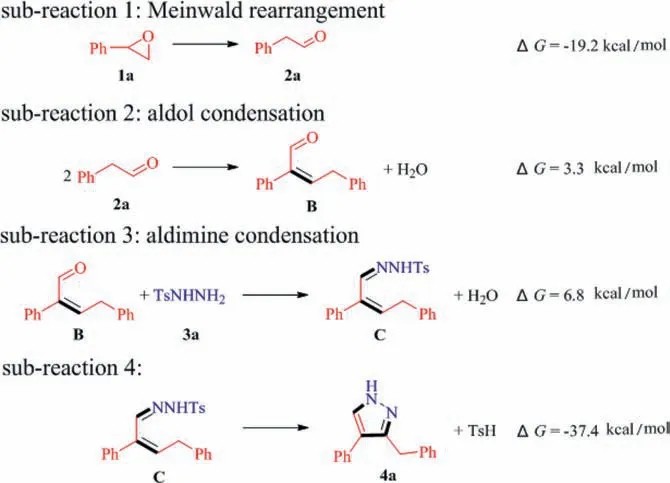
Fig.1.Four sub-reactions (1–4) and their Gibbs free energy change (ΔG) predicted by M06-2X/6–31G∗∗.

Fig.2.Proposed mechanism and calculated relative Gibbs free energies for the subreaction 4 of C to 4a based on DFT calculation.
In summary,a simple,green and practical system for the preparation of pyrazole derivatives in the presence of 4 mol%H4SiW12O40,using TsNHNH2as a nitrogen-transfer reagent under mild conditions has been demonstrated.The utilization of environmentally benign and inexpensive polyoxometalates as a highly efficient catalyst to synthesis the pyrazoles make this transformation a green procedure.Taken together with its operational simplicity,readily available reagents,and amenability to gram-scale synthesis,this green reaction will find practical applications for the synthesis of pyrazole derivatives.
Declaration of competing interest
The authors declare no conflict of interest.
Acknowledgments
This work was financially supported by the National Natural Science Foundation of China (Nos.22001034 and 21804019),the Open Fund of the Jiangxi Province Key Laboratory of Synthetic Chemistry (No.JXSC202008),the Research Found of East China University of Technology (Nos.DHBK2019264,DHBK2019265 and DHBK2019267).
Supplementary materials
Supplementary material associated with this article can be found,in the online version,at doi:10.1016/j.cclet.2021.08.037.
 Chinese Chemical Letters2022年3期
Chinese Chemical Letters2022年3期
- Chinese Chemical Letters的其它文章
- Direct catalytic nitrogen oxide removal using thermal,electrical or solar energy
- Construction and applications of DNA-based nanomaterials in cancer therapy
- Recent research progress of bimetallic phosphides-based nanomaterials as cocatalyst for photocatalytic hydrogen evolution
- Nanostructured materials with localized surface plasmon resonance for photocatalysis
- Recent progress of Pd/zeolite as passive NOx adsorber: Adsorption chemistry,structure-performance relationships,challenges and prospects
- Microfluidic methods for cell separation and subsequent analysis
